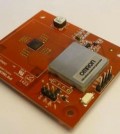7 fellows & 7 thoughts about Moore’s Law – “Moore’s Law will continue for a long time yet, but we will have to scale in a more ‘specialized’ way”

Moore’s Law is not a law of dimensions, but of economics. The law states that electronic systems will become increasingly smaller and increasingly cheaper and/or acquire more functions. The best example of this is our smartphone. In the first place, we can make systems smaller and smaller, because researchers continue to be successful in making the ultimate building block – the transistor – smaller. But you certainly shouldn’t overlook the importance of 3D integration. Concepts such as system-in-package (SiP) and system-on-chip (SoC) also make it possible to make systems more compact, without making any new technological progress in reducing the size of the elementary building blocks themselves.
In particular 3D-SoC will become very important if Moore’s Law – i.e. the miniaturization of systems – is to be able to keep on going for much longer. At the moment, 2D-SoC is used mainly. A chip is made up of various little islands, each with a specific function: a microprocessor, a memory function, an analog function, a crossbar interconnect, etc. It involves a monolithic integration of all of the parts, with all ‘islands’ produced in the same technology. If in this case, the most advanced technology is used, a SoC approach can become very expensive. Just think about using EUV lithography, which you would only want to use for chip islands that actually would benefit from this advanced technology.
To resolve this problem, there will be a shift from 2D-SoC to 3D-SoC. This latter concept allows each functional island on the chip to be produced using the most suitable (and best cost) technology. For example, for the memory function we use the most advanced technology. But this is not required for the sensor function and so we use ‘older’ technology. All of the chip components can then be stacked on one another in three dimensions. Which means you don’t have to make any compromises (which is sometimes the case with 2D-SoC). This solution makes the system cheaper, more performant and also more compact thanks to the 3D stacking.
The biggest challenge currently for 3D SoC is to make this concept economically achievable. In particular the testing of each layer of the chip has to be well developed.
For this reason, I believe that Moore’s Law will continue to apply for a long time yet, but we will have to miniaturize things in a more ‘specialized’ way. The smallest technologies will be used very specifically for the functions that benefit from it. So, it is no longer a matter of ‘one size fits all’.
About the author
Eric Beyne is program director of 3D system integration at imec. This team performs R&D in the field of high-density interconnection and packaging techniques focused on “system-in-a-package” integration, 3D-interconnections, wafer-level packaging, RF front-end design and technology using integrated passives and RF-MEMS as well as research on packaging reliability including thermal and thermo-mechanical characterization. Eric Beyne obtained a degree in electrical engineering in 1983 and the PhD in Applied Sciences in 1990, both from the University of Leuven (KU Leuven). He has been with imec since 1986. He is president of the IMAPS-Benelux committee, member of the IMAPS-Europe Liaison committee, elected member of the board of governors of the IEEE-CPMT society and IEEE-CPMT Strategic Director for Region 8.
Eric Beyne, program director of 3D system integration, imec
Contenuti correlati
-
Imec e Cadence collaborano per il tape-out del primo chip di test a 3nm
imec, il centro di ricerca e innovazione leader a livello mondiale nel settore della nanoelettronica e delle tecnologie digitali, e Cadence Design Systems hanno annunciato che la loro lunga e consolidata collaborazione ha portato al primo tape-out...
-
7 fellows & 7 thoughts about Moore’s Law – ‘Moore’s Law is primarily an economic law, but given some expansion it can also be applied to thin-film electronics’
Most people know Moore’s Law as ‘the number of transistors on a chip doubles every two years’. That interpretation was the consequence of economic considerations. Moore predicted that ‘the number of transistors on a chip will rise...
-
7 fellows & 7 thoughts about Moore’s Law – ‘Ten years from now, CMOS will seem as old-fashioned as vacuum tubes’
I’m very optimistic about the continuation of Moore’s Law. But in saying that, I’m speaking about Moore’s Law purely as an economic law. I believe we’ll be able to offer increasing amounts of functionality at lower and...
-
7 fellows & 7 thoughts about Moore’s Law – “The Internet of Power also benefits from Moore’s Law”
It may sound strange, but striving to achieve smaller dimensions with Moore’s Law is an important enabler for producing increasingly better solar cells, with a more elaborate technology toolbox (including ALD, epitaxy, etc.). Improved process steps are...
-
7 fellows & 7 thoughts about Moore’s Law – “We must teach chips to feel pain”
When I was a doctorate student in the 1980s there was lots of wild speculation about Moore’s Law: give it another 10 years and transistors will stop getting smaller, they were saying back then. But in the...
-
7 fellows & 7 thoughts about Moore’s Law – “Wearable sensors also benefit from scaling according to Moore’s Law”
My particular area of research has nothing to do directly with Moore’s Law and advanced chip technologies. We currently use 180-nanometer technology for our health sensors. So, at first sight, you could say that in technology terms,...
-
7 fellows & 7 thoughts about Moore’s Law – “Design techniques are helping to keep Moore’s Law alive longer”
Moore’s Law means that electronic products can constantly be produced more cheaply, faster and more economically. Down to 45 nm, this was due mainly to the technology that made it possible to reduce the size of transistors....
-
IMEC e iMinds: report finale del progetto CoPlaSM
IMEC, iMinds e i loro partner dell’iMinds ICON-project CoPlaSM hanno presentato, nel corso della European Utility Week tenutasi dal 4 al 6 novembre scorsi ad Amsterdam, i risultati del progetto biennale (avviato nel gennaio 2013) per realizzare e convalidare...
-
Imec e Omron: vibrazioni in energia elettrica
La collaborazione tra Imec e Omron ha generato un chip per raccolta di energia vibrazionale, in grado di alimentare i sensori in luoghi difficili da raggiungere. Il prototipo pesa solo 15,4 grammi per fornire corrente continua ai...
-
Un’elettronica sempre più “flessibile”
Fino ad alcuni anni fa l’impiego dei circuiti stampati flessibili era ristretto ad applicazioni piuttosto limitate, ma ora ci si sta rendendo conto che in talune applicazioni possono essere estremamente utili vantaggi quali il peso ridotto, l’adattabilità...

















